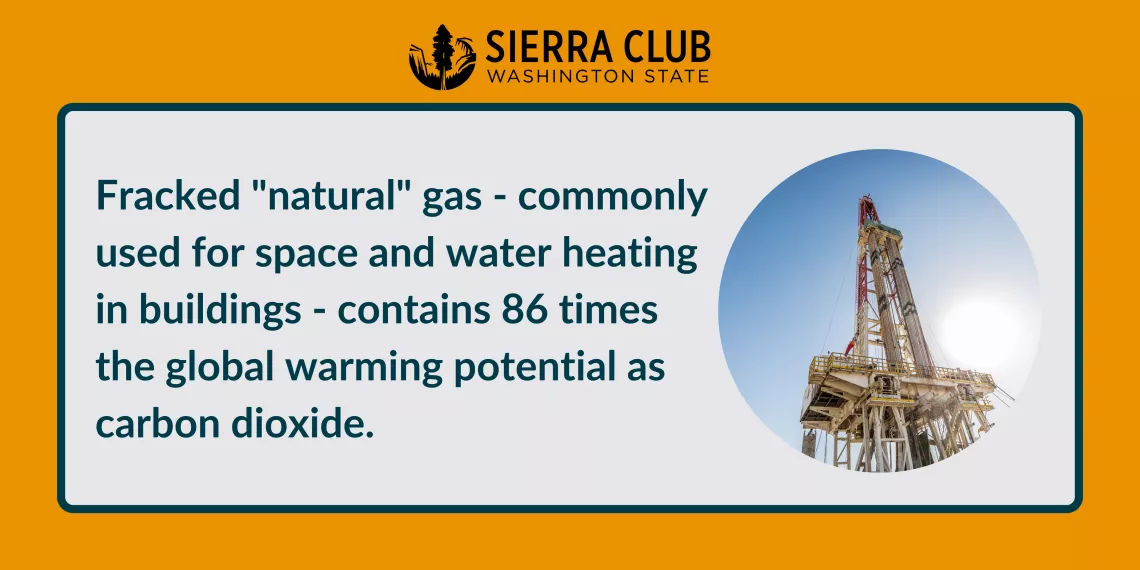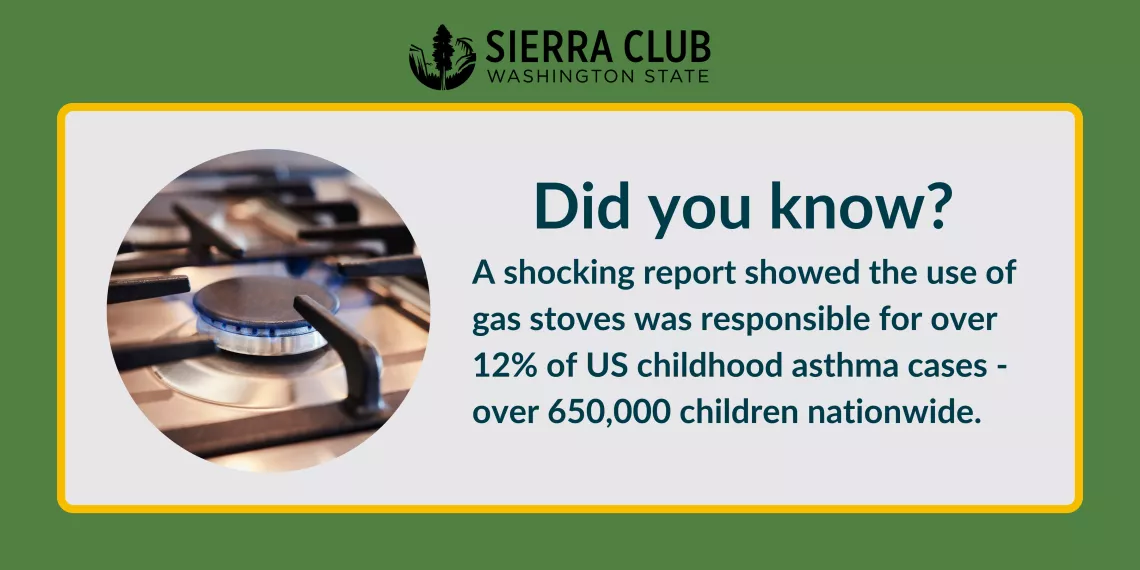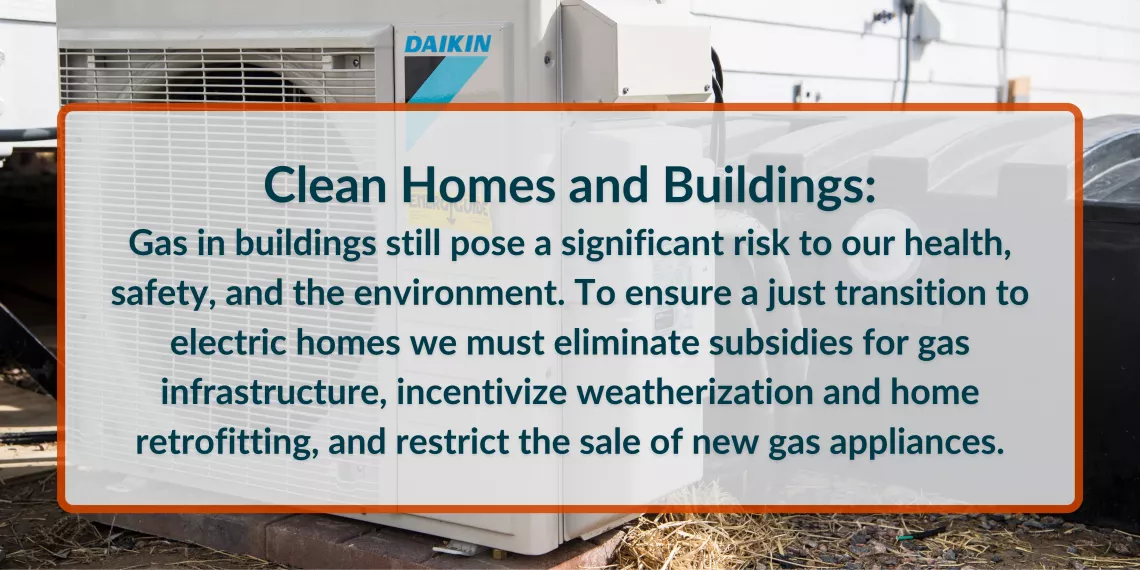In Washington State, buildings are one of the largest and fastest growing sources of emissions in the region, primarily due to the use of fossil fuels like fracked gas for space and water heating. “Natural” gas consists primarily of methane - a greenhouse gas 86 times as potent as carbon dioxide - and a large majority of gas we use now comes from the environmentally destructive process of fracking. When methane leaks are taken into account, the full climate impact of fracked gas rivals that of coal.

According to the US Energy Information Administration, in 2018, burning fossil fuels in the buildings sector in Washington produced 18 million metric tons (MMT) of carbon dioxide equivalent (CO2e). These emissions are equivalent to the annual emissions from 3,957,182 cars or 5 coal plants, and amounts to 19% of the total emissions from fossil fuel combustion in the state.
Thanks to Washington state’s abundance of clean, low-cost electricity, swapping out gas appliances for electric alternatives is a huge climate win. This switch would reduce the average household’s climate footprint by 50% - the equivalent of completely giving up your car. Multiple studies, including the Washington State Department of Commerce’s recently completed draft state energy strategy, have identified hooking buildings up to our increasingly clean electricity as the most cost-effective pathway to a decarbonized building sector.

The emissions from these appliances aren’t just hurting our climate. According to data from a Harvard study conducted May 2021 and RMI analysis, fossil fuel appliance pollution was responsible for 53 premature deaths in Washington in 2017. Additionally, with over 11 million metric tons of greenhouse gases per year, the total monetized health and climate impacts of appliance pollution are estimated to be at least $1 billion annually. Another shocking report showed the use of gas stoves was responsible for over 12% of US childhood asthma cases - that’s over 650,000 children nationwide. As the body of research grows, it is clear that burning fracked gas in our homes and our communities is an immediate threat to the health of ourselves and our families.
There’s also the issue of safety, particularly for communities prone to major earthquakes. Gas appliances increase the risk of household fires through small methane leaks from pipes, meters, and appliances in the home. Communities around the country have seen major gas explosions in recent years, including right here in Seattle. In 2013 an improperly decommissioned Puget Sound Energy gas line caused a massive explosion in the Greenwood neighborhood, closing multiple neighborhood businesses for a year or more. On average, between 2016-2018, a gas pipeline incident has killed someone, sent someone to the hospital, and/or caused a fire and/or explosion once every 4 days nationwide.
While recent changes to the Washington state energy codes have almost completely halted the construction of new buildings using gas for space and water heating, existing buildings continue to pose a significant barrier to reaching net zero emissions. In order to stop the climate crisis, reduce polluting emissions and protect public health and safety, Washington must transition its existing buildings off of fossil fuels and to clean, renewable electricity, and ensure that historically marginalized households are prioritized for this transition. Thankfully, there are plenty of solutions, and with the passage of the Inflation Reduction Act in Congress, unprecedented resources for this transition.

In order to ensure a just transition to all electric homes and buildings, we must:
- Eliminate subsidies for new gas infrastructure;
- Create programs to utilize local, state and federal funding to weatherize and retrofit homes with a focus on low income and historically marginalized households;
- Transition large commercial buildings off of gas through policies such as building performance standards, which are currently being considered by cities like Seattle; and
- Restrict the sale of new gas appliances in the coming decade, pursuing appliance emissions standard policies such as the ones being considered by the California Air Resources Board (CARB) and Bay Area Air Quality Management District (BAAQMD).
Finally, new jobs retrofitting buildings should be prioritized for unionized work forces in communities of color that are disproportionately impacted by fossil fuel pollution, and these communities should be the first to enjoy the indoor air quality benefits of new electric appliances. We’ll work to make sure workers, low-income people, and communities of color are prioritized.
Healthy homes and clean buildings are an essential part of the clean, equitable future we’re all working to create together. Stay tuned in the coming months for more updates and opportunities to make your voice heard.